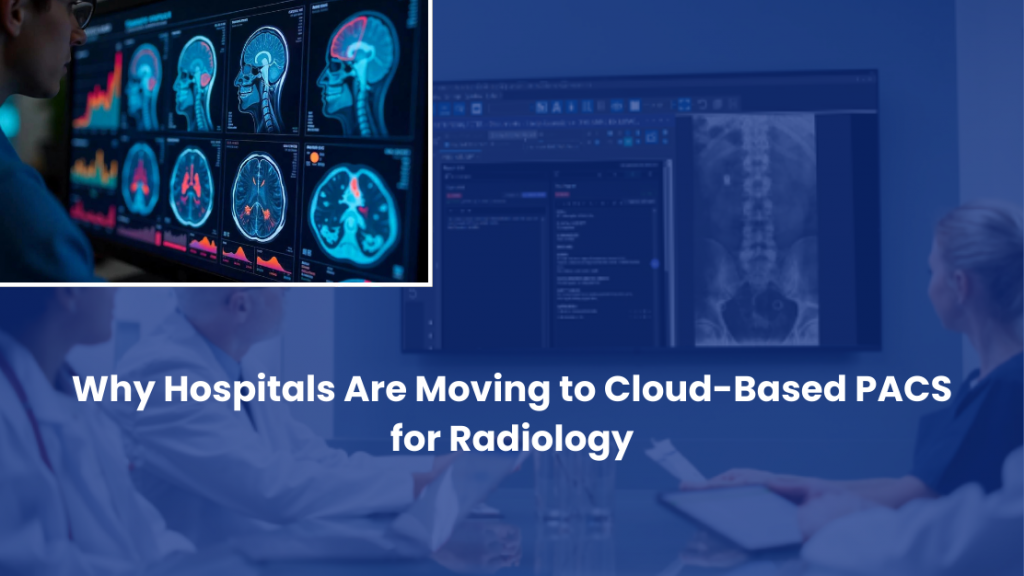In today’s fast-evolving healthcare landscape…
Hospitals are under pressure to enhance efficiency, reduce costs, and deliver faster, more accurate diagnoses.
One major shift supporting this transformation is the move from traditional on-site Picture Archiving and Communication Systems (PACS)
to cloud-based PACS solutions. Cloud-based PACS is revolutionizing how hospitals store, manage, and share medical imaging, creating
a smarter, more scalable approach to radiology.
What is a Cloud-Based PACS?
A cloud-based PACS is a digital image management system that allows healthcare providers to store, access, and share radiology images like
X-rays, CT scans, and MRIs over the internet. Unlike traditional PACS that rely on in-house servers and complex infrastructure,
cloud-based PACS uses secure cloud storage, offering accessibility and scalability from virtually anywhere.
Key Reasons Hospitals Are Switching to Cloud-Based PACS
1. Anywhere, Anytime Access
With cloud-based PACS, radiologists and physicians can access medical images remotely—whether from another hospital department, a clinic, or even home.
This level of accessibility enhances collaborative diagnostics and accelerates patient care. For hospitals with multiple branches or radiologists working
in different locations, cloud access removes barriers and enables instant image sharing across teams.
2. Cost Efficiency and Lower IT Overhead
Traditional PACS involves significant capital investment in servers, storage hardware, IT maintenance, and software licenses.
Cloud-based PACS eliminates much of this infrastructure by shifting to a subscription or pay-as-you-go model. Hospitals save on upfront costs,
reduce IT staffing needs, and avoid the regular expenses of system upgrades, hardware replacement, and energy consumption.
3. Scalability with Growing Imaging Volumes
As radiology departments handle increasing volumes of high-resolution imaging data, scalability becomes critical. Cloud-based PACS offers
virtually unlimited storage, which can grow seamlessly with hospital needs—no need to purchase or install additional servers. This scalability
is particularly beneficial during emergencies, seasonal surges, or when expanding hospital services.
4. Faster Disaster Recovery and Data Security
Cloud providers offer enterprise-grade security with features like encryption, role-based access and multi-factor authentication.
Additionally, cloud PACS includes automated backups and disaster recovery protocols, ensuring that patient data is protected against
hardware failure, natural disasters, or cyberattacks. This level of security often exceeds what many hospitals can afford to implement on-premises.
5. Enhanced Collaboration Between Specialists
Cloud-based PACS enables secure, real-time sharing of imaging data with external specialists, second opinion centers, or teleradiology services.
This improves diagnostic accuracy and speeds up treatment planning, especially in critical care or oncology. The cloud also allows integration
with Electronic Health Records (EHR), creating a centralized platform where physicians can review complete patient histories.
6. Compliance with Medical Standards and Regulations
Many cloud PACS vendors comply with global healthcare data protection standards such as HIPAA (USA) and ISO certifications.
This ensures that hospitals stay compliant without having to manage all legal obligations on their own. The cloud also allows for audit trails,
user tracking, and automated reporting, which improves transparency and regulatory readiness.
7. Quicker Implementation and Updates
Deploying traditional PACS can take weeks or even months. Cloud PACS can be implemented in days, often without the need for on-site hardware setup.
Furthermore, vendors handle software updates, security patches, and performance optimization without disrupting hospital operations.
This enables hospitals to stay updated with the latest features and compliance changes automatically.
8. Support for AI and Advanced Analytics
Modern cloud-based PACS platforms integrate easily with artificial intelligence (AI) tools that assist in image interpretation, anomaly detection,
and workflow optimization. These tools enhance diagnostic precision and help reduce human error. Cloud platforms offer the computational power
needed to support machine learning models—something traditional PACS systems often struggle with.
Real-World Impact: Faster Diagnoses, Better Patient Outcomes
Hospitals that adopt cloud-based PACS report faster turnaround times, fewer diagnostic delays, and smoother workflows across departments.
Patients benefit from quicker access to reports and fewer repeat scans due to lost or inaccessible data. With increased collaboration,
hospitals can provide second opinions and expert consultations rapidly, even across international boundaries.
Final Thoughts
The shift to cloud-based PACS in radiology is not just a technological upgrade—it’s a strategic move toward smarter, more patient-centered care.
Hospitals gain operational flexibility, reduce IT burden, improve data security, and unlock new levels of collaboration.
As healthcare continues to evolve, cloud-based PACS offers a future-ready solution for hospitals seeking efficiency, agility, and innovation in medical imaging.
